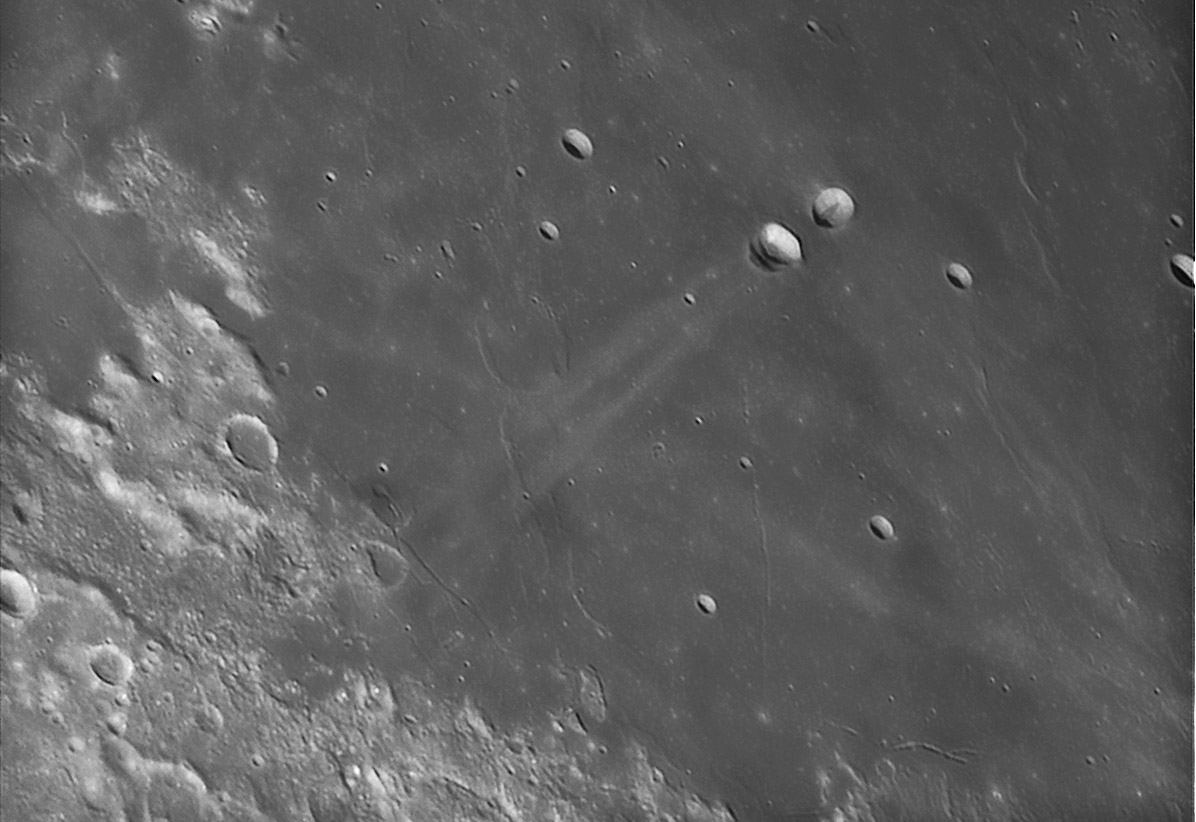Difference between revisions of "November 6, 2011"
| (2 intermediate revisions by the same user not shown) | |||
| Line 6: | Line 6: | ||
<em>image by [mailto:tosi.philippe@wanadoo.fr Philippe Tosi]</em><br /> | <em>image by [mailto:tosi.philippe@wanadoo.fr Philippe Tosi]</em><br /> | ||
<br /> | <br /> | ||
| − | The Moon is a much simplier world than Earth, Mars or TItan. These three have atmospheres and flowing (past tense for Mars) | + | The Moon is a much simplier world than Earth, Mars or TItan. These three have atmospheres and flowing (past tense for Mars) |
| − | liquids that eroded and deposited materials. Two and maybe three have frozen liquids that also gouged, eroded and redeposited | + | liquids that eroded and deposited materials. Two and maybe three have frozen liquids that also gouged, eroded and redeposited |
| − | rocks and sediments. And at least Earth has a dynamic interior that moves the upper 100+ km thickness of rocks around the | + | rocks and sediments. And at least Earth has a dynamic interior that moves the upper 100+ km thickness of rocks around the |
| − | globe like drunken bumper cars. But the Moon seems to have been altered by no processes other than impact cratering and | + | globe like drunken bumper cars. But the Moon seems to have been altered by no processes other than impact cratering and |
| − | volcanism. Even lunar tectonics - faulting and folding - were direct consequences of cratering and volcanism. So look at Philippe's | + | volcanism. Even lunar tectonics - faulting and folding - were direct consequences of cratering and volcanism. So look at Philippe's |
| − | great image taken from Pic du Medi and identify the features of endogenous or exogenous origin - or to skip the geological jargon - | + | great image taken from Pic du Medi and identify the features of endogenous or exogenous origin - or to skip the geological jargon - |
| − | internal or external origin. I see at least six types of landforms resulting from internal activity and five or more from impact. And, | + | internal or external origin. I see at least six types of landforms resulting from internal activity and five or more from impact. And, |
| − | of course, some rely on the interplay of the two. What do you see?<br /> | + | of course, some rely on the interplay of the two. What do you see? |
| + | <br /> | ||
<br /> | <br /> | ||
<em>[mailto:tychocrater@yahoo.com Chuck Wood]</em><br /> | <em>[mailto:tychocrater@yahoo.com Chuck Wood]</em><br /> | ||
| Line 21: | Line 22: | ||
<br /> | <br /> | ||
<strong>Related Links</strong><br /> | <strong>Related Links</strong><br /> | ||
| − | Rükl plate [ | + | Rükl plate [https://the-moon.us/wiki/R%C3%BCkl_48 48]<br /> |
<br /> | <br /> | ||
| + | <hr /> | ||
<p><b>Yesterday's LPOD:</b> [[November 5, 2011|Almost On the Ground with Apollo 15]] </p> | <p><b>Yesterday's LPOD:</b> [[November 5, 2011|Almost On the Ground with Apollo 15]] </p> | ||
<p><b>Tomorrow's LPOD:</b> [[November 7, 2011|Two (Or Three) Ring Circus]] </p> | <p><b>Tomorrow's LPOD:</b> [[November 7, 2011|Two (Or Three) Ring Circus]] </p> | ||
| − | < | + | <!-- End of content --> |
{{wiki/ArticleFooter}} | {{wiki/ArticleFooter}} | ||
Latest revision as of 18:55, 13 October 2018
Internal or Ex?

image by Philippe Tosi
The Moon is a much simplier world than Earth, Mars or TItan. These three have atmospheres and flowing (past tense for Mars)
liquids that eroded and deposited materials. Two and maybe three have frozen liquids that also gouged, eroded and redeposited
rocks and sediments. And at least Earth has a dynamic interior that moves the upper 100+ km thickness of rocks around the
globe like drunken bumper cars. But the Moon seems to have been altered by no processes other than impact cratering and
volcanism. Even lunar tectonics - faulting and folding - were direct consequences of cratering and volcanism. So look at Philippe's
great image taken from Pic du Medi and identify the features of endogenous or exogenous origin - or to skip the geological jargon -
internal or external origin. I see at least six types of landforms resulting from internal activity and five or more from impact. And,
of course, some rely on the interplay of the two. What do you see?
Chuck Wood
Technical Details
Oct 2011. C.14 telescope with barlow1.8x and Ir 472 nm filter + Skynyx 2.1 M camera; processing by Registax 6 and Photomatix 4 pro with tone mapping mode light
Related Links
Rükl plate 48
Yesterday's LPOD: Almost On the Ground with Apollo 15
Tomorrow's LPOD: Two (Or Three) Ring Circus
COMMENTS?
Register, Log in, and join in the comments.



